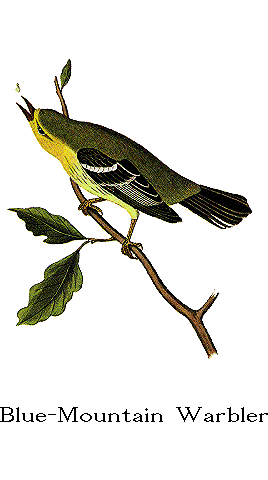Birds of America
By John James Audubon, F. R. SS. L. & E.
VOLUME II.



Family
Genus

BLUE-MOUNTAIN WARBLER.
[Blue Mountain Warbler.]
SYLVICOLA MONTANA, Wils.
[Sylvia montana.]

PLATE XCVIII.--MALE.
It is somewhat strange, that among the numerous species of birds that visit
the United States, a few should have been met with only in rare instances. The
present Warbler is in this predicament, as it does not appear that many
specimens have been obtained excepting that from which this figure and
description were taken. For many years I never met with Bewick's Wren, which is
now, however, known to be abundant on the mountains of Virginia, and elsewhere
in our Middle and Southern Districts, and still more so along the Columbia
river. The same was the case with Henslow's Bunting, which has become a common
bird in the State of New Jersey, where it breeds, and in South Carolina and the
Floridas, where it spends the winter. Of Townsend's Bunting the only specimen
as yet procured is in my possession; and it is only of late years that
Macgillivray's Finch has appeared in numbers in the neighbourhood of Charleston.
Swainson's Warbler, at one time scarce in South Carolina, where it was
discovered by my good friend Dr. BACHMAN, has since been procured as far
eastward as the vicinity of Boston by THOMAS M. BREWER, June., Esq. The Pipirie
Flycatcher was not known to exist eastward of the Floridas until after I had
found it there, although now it is not a scarce species, being found breeding in
the very heart of the city of Charleston. Traill's Flycatcher, which I first
discovered on the Arkansaw river, is now known to abound on the Columbia river.
No other person has observed the Rocky Mountain Wren in any part of the country
eastward of that great chain besides Dr. BACHMAN, who shot one within a few
miles of Charleston. I might mention several other species, which at one time
were extremely rare in the United States, but are now abundant in many of our
districts; but prefer returning to the Blue-Mountain Warbler, which it has not
been my good fortune to meet with, although it would be in no degree surprising
to find it a constant visiter to some portions of our vast country yet untrodden
by the ornithologist. My figure was taken from a specimen lent to me by the
Council of the Zoological Society of London, and which had come from California.
ALEXANDER WILSON, to whom we are indebted for our knowledge of this pretty
bird, says that it "was first discovered near that celebrated ridge, or range of
mountains, with whose name I have honoured it. Several of these solitary
Warblers remain yet to be gleaned up from the airy heights of our alpine
scenery, as well as from the recesses of our swamps and morasses, whither it is
my design to pursue them by every opportunity. Some of these, I believe, rarely
or never visit the lower cultivated parts of the country, but seem only at home
among the gloom and silence of those dreary solitudes. The present species
seems of that family, or subdivision, of the Warblers, that approach the
Flycatchers, darting after flies wherever they see them, and also searching with
great activity among the leaves. Its song was a feeble screep, three or four
times repeated.
"This species is four inches and three-quarters in length; the upper parts
a rich yellow-olive; front, cheeks, and chin yellow; also the sides of the neck;
breast and belly pale yellow, streaked with black or dusky; vent plain pale
yellow; wings black; first and second row of coverts broadly tipped with pale
yellowish-white, tertials the same; the rest of the quills edged with whitish;
tail black, handsomely rounded, edged with pale olive; the two exterior feathers
on each side white on the inner vanes from the middle to the tips, and edged on
the outer side with white; bill dark brown, legs and feet purple-brown; soles
yellow; eye dark hazel.
"This was a male. The female I have never seen."
BLUE-MOUNTAIN WARBLER, Sylvia montana, Wils. Amer. Orn.,
vol. v. p. 113.
SYLVIA TIGRINA, Bonap. Syn., p. 83;
but not of Gmelin or Latham, as the figure of Edwards,
to which reference is made, has the tail not rounded, but emarginate.
BLUE-MOUNTAIN WARBLER, Sylvicola montana, Nutt. Man., 2nd ed.,
p. 442.
BLUE-MOUNTAIN WARBLER, Sylvia montana, Aud. Orn. Biog.,
vol. v. p. 294.
No bristles at the base of the bill; wings rather short, the third and
fourth quills longest; tail much rounded. Upper parts light greenish-olive; a
band across the forehead, one over the eye, the cheeks, throat, fore part and
sides of neck bright yellow; the rest of the lower parts yellowish-white; the
sides marked with narrow longitudinal dusky streaks; wings dusky brown, all
the feathers edged with yellowish-white, the secondary quills more broadly, the
first row of small coverts and the secondary coverts tipped with white, forming
two conspicuous bands; tail brownish-black, the feathers edged with
yellowish-green, the two outer on each side white in their terminal half.
Male, 4 1/12, wing 2 6/12.
Blue Mountains of Virginia, and west of the Rocky Mountains.









